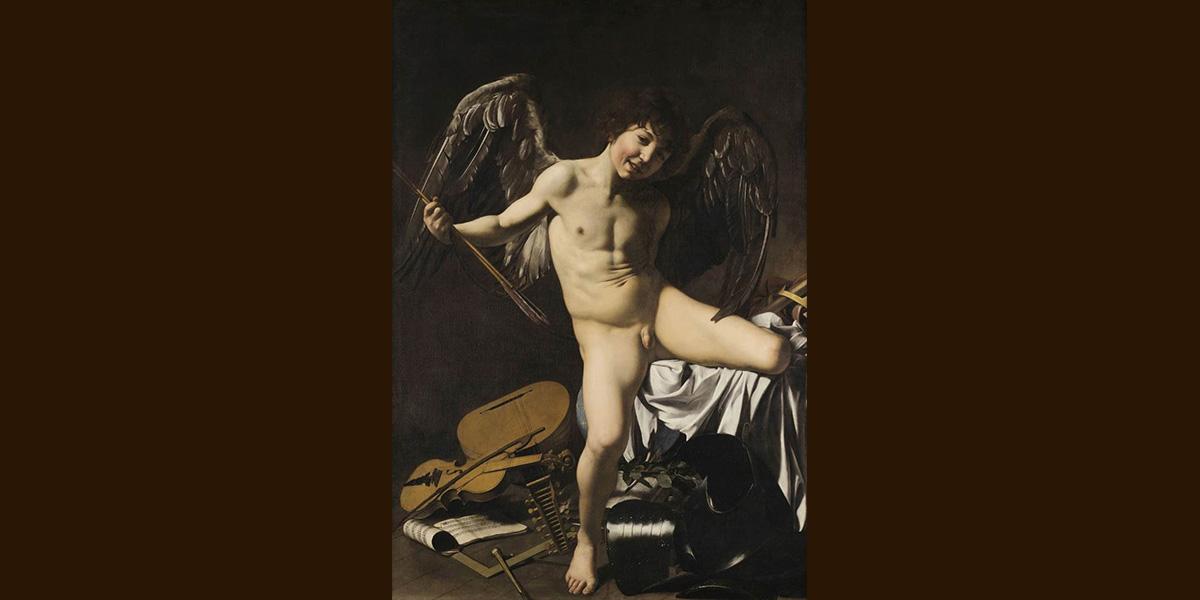The Wallace Collection has secured Victorious Cupid — the brazen, smirking, bare-fleshed Caravaggio masterpiece painted around 1601–02. This is the first time it has been shown in Britain. The painting arrives on loan from Berlin’s Gemäldegalerie. It will anchor a compact, atmospheric exhibition opening late November, flanked by two ancient Roman sculptures that once stood alongside it four hundred years ago, like silent chaperones who failed to rein in Cupid’s mischief.
The backstory is cinematic. These works belonged to Marchese Vincenzo Giustiniani — part banker, part philosopher-collector, fully wealthy beyond sense — who lived with his brother, Cardinal Benedetto, in a sprawling palazzo near the Pantheon. Imagine long candlelit chambers, tapestries breathing dust, and a private gallery containing no fewer than fourteen Caravaggios. Victorious Cupid wasn’t hidden away: it hung proudly in what the Marchese called his stanza grande de’ quadri antichi — his great room of ancient paintings — rubbing shoulders with The Lute Player, an Inspiration of Saint Matthew whose angel seems alarmingly sensual, and works by Raphael, Giorgione, Titian, and Andrea del Sarto.
His sculpture gallery downstairs was an encyclopedic parade of ancient statuary arranged with wit, scholarship, and a touch of aristocratic arrogance. Giustiniani didn’t merely collect — he staged, provoked, and theorised. He wanted visitors to leave both entertained and intellectually wound.
The painting itself was shocking at the time. A near life-size boy, probably twelve, stands naked, wings attached, weaponised with arrows and a grin that reads halfway between seduction and mockery. He is painted from life, not idealised, not angelic. On the floor, scattered: musical instruments, armour, mathematical tools, wreaths, symbols of power, intellect, culture — all toppled by love’s reign. A celestial globe slices behind him, like a planetary punchline: not even the world escapes desire.

The Wallaces’ curatorial approach aims to recreate the sensation of stepping into Giustiniani’s palace: architectural illusions, printed vistas, maps, Roman echoes, and a sense that Rome’s labyrinthine 17th-century streets — with their taverns, studios, chapels, duels, debts, and back-stairs rivalries — are only one doorway away. Caravaggio’s Rome was a compact, volatile, nocturnal, and brilliant city. This exhibition hints at that compressed pressure, that tight city where genius and violence slept together.
Visitors will be able to compare Cupid directly with the paired Roman sculptures, as Giustiniani intended. It’s more than a curatorial flourish; it recreates the era’s favourite intellectual sport — paragone, the competition between the arts, ancient versus modern, marble versus flesh on canvas. There’s even speculation that the painting originally sat behind a curtain, theatrically unveiled for maximum shock value — a Baroque jump-scare before electricity was invented.
Remember, Caravaggio painted this at the peak of his acclaim. Everyone wanted his work; everyone envied or feared the talent. His contemporaries marvelled at the luminous skin, the startling realism, the psychological charge. The nudity, however blunt, barely raised a recorded eyebrow — perhaps they were too enthralled or too polite to say what they really saw.
Then the fall: in 1606, he killed a man during a street brawl, fled Rome, and spent his remaining years ricocheting between courts, commissions, and safe houses until his mysterious death in 1610, reportedly collapsing near Porto Ercole as he attempted to return.
Dr Xavier Bray, the museum’s director, calls Victorious Cupid “the ultimate Caravaggio painting,” a union of sacred and profane, rendered in luminous flesh and violent shadow. He promises an exhibition that “evokes the Palazzo Giustiniani and the world of 17th-century Rome.” Frankly, if they land even half that ambition, this will be one of London’s must-see winter shows — a chance to stare down a smirking god who conquered the world with nothing but skin, arrows, and nerve. – PCR
Caravaggio’s Cupid, 26 November 2025 – 12 April 2026: Caravaggio’s masterpiece, which has never been seen in public in the UK before, will go on display, free at London’s Wallace Collection from late November.
Admission FREE

